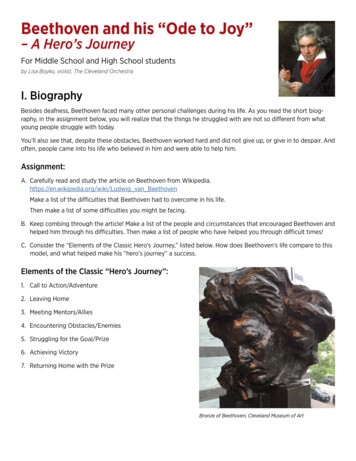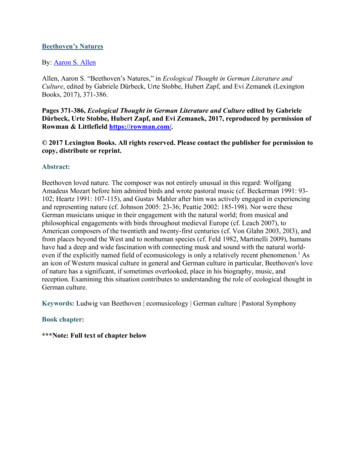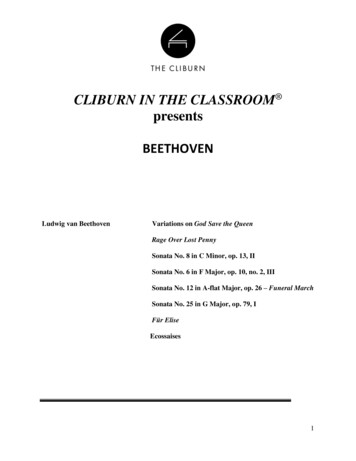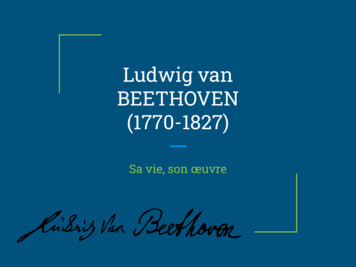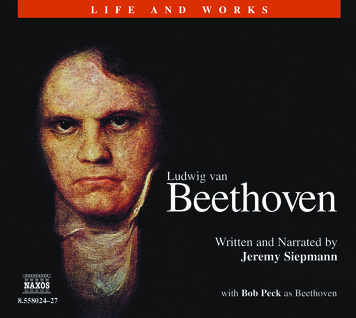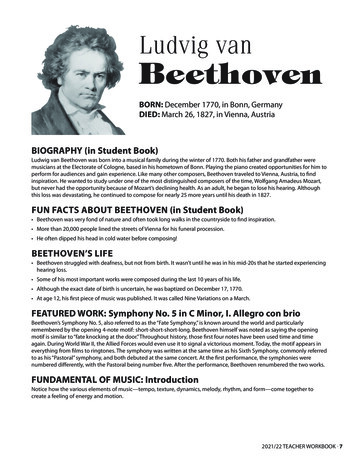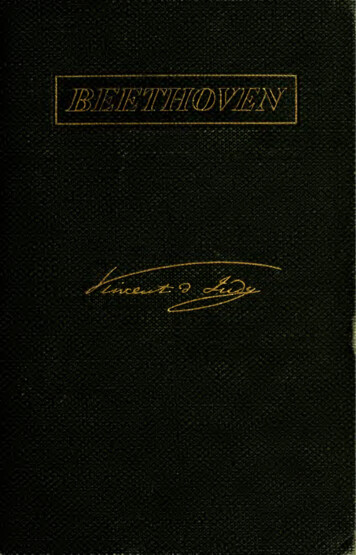
Transcription
.) ML4I0.B4X7 5Given ByRissland Fund
E
BEETHOVENA CRITICAL BIOGRAPHYByVINCENT D'INDYTRANSLATED FROM THE FRENCHBy DR.THEODORE BAKERm.Boston, Mass.:NEWYORK:G.PARIS: HENRITHE BOSTON MUSIC COMPANYSCHIRMER, INC.LAURENSLONDON: G. SCHIRMER, LTDSYDNEY: PALING & CO., LTD.
e,t 'flnZOOPYRIGHT, 1911,B-yHENRI LAURENSCopyright assigned,1913,THE BOSTON MUSICtoCO,Sole owners of the exclusive rights to the English translation,for all countries.B.M.Co., 37247s
CONTENTSPAGEIntroductionThe1First Period, until 1801[.11.His LifeHis Music (Imitation)The SecondIII.413Period, from 1801-1815His LifeIV. His26Music (Trans ition)42The Love of Woman46The Love of Nature54The Love of Country 63The Third Period, from 1815-1827V.His LifeVI. HisVII.Music74(Reflection)90The Sonata 102The Quartets105The Lieder and the CanonsIllThe Ninth Symphony and the Missa Solemnis114Methodical and Chronological List of Beethoven's WorksList ofYouthful Works(1782-1793)ICompositions of First Period (1793-1801)Compositions OF SEco?ii Pttrtod (1001 1315)Compositions of Third Period (1815-1827)TABLEII.IllIV
ILLUSTRATIONSFacing pageSilhouette of Beethovenwhen a Youth6(1786)Organ of the Minorites at Bonn (Beethoven Museum, Bonn).Title Page of Beethoven's First Printed Composition614Beethoven's Three Instructors: Neefe, Albrechtsberger,Haydn20Beethoven at the Age of Twenty-sixNew(1796),by Stainhauser.Year's Card to the Baroness von Ertmann (1804)Beethovenin 1804,2432by Mahler42Giulietta Guicciardi (1801)48View of Dobling, at the Foot of the Kahlenberg56Autograph Sketch for "Egmont"64Beethoven in1814,(1809)by Letronne72Archduke Rudolph of AustriaBeethovenin 1824, by78DeckerAutograph from the 13th Quartet90106(1825)The Beethoven Memorial Monument at ViennaBeethoven's First Tomb, in the Cemetery at Wahring.114.122
LUDWIG VAN BEETHOVENINTRODUCTIONOnly he who has never Hved in intimate communion withBeethoven's art would venture to assert that the productionssymphony present themselves under butone aspect, so that no essential modification can be distinguished in the course of a career which, opening with a fewof the genius of theinsignificant variations, closed with the five last quartets.In support of the opinion which would suppress the divi-works into periods, strongly markedthough they be, we can find nothing to cite except a letterfrom Franz Liszt to Councilor Wilhehn von Lenz, theprincipal advocate of the 'Hhree styles."In this letter thecelebrated virtuoso, after having first of all declared Beethoven's creative work to be one and indivisible, ends byhimself dividing it into two categories instead of threeanentirely arbitrary and illogical arrangement.On all whoknew the composer of the Faust Symphony and his refinesion of Beethoven's—mentof appreciation this letter willmakethe impression ofa mere freak of humor, or possibly even one of those solemnmystifications which, as a good romancer, he had a habit ofbringing forward in his letters or conversation, with thegreatest emphasis, for the astonishment of reader or auditor,thereafter laughing overthemin private.Atallevents,ifsuch was his view in 1852, he professed twenty years later anopinion diametrically opposed, when it was our privilege to[1]
LUDWIG VAN BEETHOVENin Weimar, and when he uttered such judion the subject of the three Beethovens: ''thechild, the man, the god."Hence, no serious criticism wouldattach to the document in question any greater importancethan to the dogmatic pronouncements of those "Wagnerizers" who decreed, about the year 1890, the absoluteartistic identity of Parsifal, Tannhduser, and — Rienzi.dwell nearhimcious remarksItappears certain that the career of every al duration, divides into three periodsone from the other in the character of the composi-Imitation, transition, reflection.In thefirstperiod, after having studiedmoreor less atlength the rules and traditional processes of the trade, theartist will unitate.Not one ofthe grand pioneers in poetry,—an Alighieri no morethan a Moliere, a Gozzoli no more than a Rembrandt, a Bachno more than a Wagner. Before this law the too-convenienttheory of autodidactic geniuses falls to the groundatheory of which, it must be admitted, the history of art offersnot a single example.Following this period of imitation, whose duration varieswith different composers (in Beethoven's case it occupiedeight years of his life), the young artist gradually frees himself from his leading-strings.He tries to walk alone. Then,with an increasingly vivid consciousness of the joyous orsorrowful movements of his soul, it is hi7nself that he seeks,not without hesitations and gropings, to express in his art.With some, like Bach or Haydn, it will be the tranquillityof the trusting soul (Allemande of the Fourth Partita forharpsichord, by Bach), or mayhap a wholesome gayetypainting or music has evaded this law—bordering on roguishness (Haydn's[2]finales).With others
LUDWIG VAN BEETHOVEN(Beethoven, for example)feeling of ruralcalm;willitwithall itbe poignant passion, or thewill be the attempt to makebyhuman, to putmanifest, in their works, the emotions created in the soulthe events ofitlife.Aperiodcorrectly, a period inmoreespeciallywhich external procedure, execution,occupies a large place, a period preparing for the artist theway to a definitive eclosion of his personality.To this manner would seem to belong (to mentiononly afew works) the Convivio of Dante, the Night-Watch of Rembrandt, the chamber concertos of Bach, Tristan by Wagner.And finally, when the man of genius, weary of expressinghis own joys and his own sorrows, disdainful or careless of hisenvironment, shall concentrate within himself his incessantaspiration after pure beauty, the instant has arrived, for menof highest stature, for the supreme transformation, the timefor works of pure Art, of Faith and of Love.Such are Dante's Divine Comedy, Fra Angelico's frescos inthe chapel of Nicholas V., Rembrandt's Syndics, Bach'sMass in B minor, Richard Wagner's Parsifal.In the above we have outlined the productive life-historyof almost all, not to say all, those men who are worthy to becalled artistic geniuses.In not one among them can thesevarious transformations be traced more readily than inBeethoven, by a study of their works, and, so to speak, stepby step. We shall make this studyrestricted perforce toan examination of the most characteristic worksthe object—of the following pages.[3—
THE FIRST PERIODUntil 1801IHIS LIFEIn Bonn that evening there was a festival at number 934narrow street which is called the Rheiiigasse (RhineAlley).In the Beethovens' dwelling they were celebratingthe day of Mary Magdalen in honor of the mistress of theof thehouse, nee MariaMagdalena Keverich, and quite a numberwere gatheredcomrade Johannof musicians belonging to the Electoral Kapelletogether in thehomeof the court tenor, theirvan Beethoven, to aid him in regaling his guests with a littlemusic interspersed with grilled sausages, refreshments andmerrytalk.In the ''best room" {gute Stube) a harpsichord and musicdesks have been ranged in order. Under the canopy adornedwith foliage, where Frau van Beethovenis about to take herframe the portrait of KapellmeisterLudwig van Beethoven, the household Lar, the illustriousplace, appears in a giltmanof the family.*Radoux, portrait-painter to the Court, depicted himsize,in life-clad in a fur cloak with a long-sleeved over-mantle,* Itwas through him that the Beethoven family tracedtheir con-nection with that Netherlandish homeland whence they were broughtby the whimofanElector of Cologne.was the descendantecclesiastical Maecenas,Clement Augustus, Prince-Kapellmeister Ludwig, born at Antwerp in 1712,of a line of artistspainters and sculptors.[4]among whom were numbered
LUDWIG VAN BEETHOVENseated in an armchair, a velvet cap with gold tassel on hishead, asmallmusic in his hand; in general appearance awith broad forehead, keen eyes and dark com-roll ofmanplexion.At the harpsichordsitsanother Ludwig.It is theboy barely eight years of age(he was born the 16th of December, 1770), who is makingready to play a sonata by Mozart or Ph. Emanuel Bach underoldest of his grandchildren, athe kindly eyes of the musicians of hisRies,Simrock,theRomberg's,companythe actor Lux,— Reicha,etc.Hisand short legs seem to find difficulty in supporting an enormous head which one might fancy descendedslender frameout of the rejuvenated portrait.He, too, has the black hairand dark complexion which are to earn him the sobriquet of'Hhe Spaniard." His precocious talents already promise anew link in the unbroken chain of Kapellmeister.Nearby, tenderly gazing on him, we see Frau van Beethoven, still young and pretty, albeit somewhat faded.Adaughter of respectable burgher-folkher father was chiefcook to the Prince-Electorthis excellent housewife, whois at the same time a woman of distinction, can suitablyconform her speech to the humblest and to the most exaltedpersonages." She is idolized by the three little boys, Ludwig,Carl and Johann; and, although her husband inherited fromhis mother's side an immoderate liking for the juice of hisRhenish grapes, no disputes have disturbed the harmony of——the household.father willfall,Later,whenin a celebrated letter, willheart, of that*' she dies of consumption, thea hopeless wreck; and the youthful Ludwig,pour out thefirst affliction of hisheart in which everything reechoes."*All passages in quotation-marks are authentic citations from Beet-hoven's spoken or written words, without further indication of theirsources.[5]
LUDWIG VAN BEETHOVENIn a corner of the room a monk is listening most attentivelyIt is an organist, Father Hanzmann,who never fails to appear at these reunions. With theto the family concert.Franciscan brother, Willibald Koch, he divides the honor ofhaving been one of Beethoven's first organ-teachers.Lastly, in the background, a tall, handsome man ofelongated visage and somewhat severe mien, a powderedperiwig on his headthe father of the family.—down to us by goodmanand caterer to the corporation ofmusicians, who, in this capacity, was sometimes invited tojoin the friends.A far different picture, it must be admitted,from that exhibited to us by romantic writers a trifle overwrought by a passion for the dark side of life. Instead of aBeethoven maltreated and beaten, always in tears, we see achild energetically urged to work by his father, who recognized his great abilities and who, with very pardonable pride,pr/iduced him at a concert as even younger than he was.Suchisthe tableau handedFischer,* the family bakery The child was, in very truth, a dreamer; neighbors whocame to listen beneath the window might often have seenhim lost in contemplation of the broad Rhine and the SevenMountains. But, aside from this, he enjoyed and foundunhooking the landlord'sbhnds to make them creak, purloining Mother Fischer'stime for the pranks of youth;eggs C'lamwhen accusedonly a note-snatcher," he laughingly repliedof beingan egg-snatcher), or wanderinginvacation-time through his beloved country, and picking uphere and there certain fieldfare-pies wherewith the curates* See the MS. by Fischer in the Beethoven House at Bonn; and c/.Thayer's Biography, second edition (German), Vol. I, pp. 117-125, andthe Suppl., VII, pp. 415-448.[61
SILHOUETTE OF BEETHOVEN, AGED SIXTEENORGAN AT THE MONASTERY OF THE MINORITES, IN BONN, WHEREBEETHOVEN LEARNED TO PLAY(Beethoven Museum, Bonn)
LUDWIG VAN BEETHOVENof theneighborhood would regale him in recompense for animprovisation on the organ.Hisfirstinstructors were his cousin, the pious Rovantini,kindliness itself;Pfeiffer,whose alleged ill-treatmentleftnobitterness in his pupil's spirit, since the latter did not hesitate, some years later, to aid his old master in time of need;and Neefe, the court organist, who had made of the littlevirtuoso, the young amateur, aged twelve, his deputy in theElectoral chapel.Thanks to him, Beethoven will soonoccupy a salaried position bringing in 150 florins. And then,how proud was his father to escort the little gentleman of aSunday through the streets of Bonn in his gala costume:—alight green coat, a vest ofembroideredsilkwith greatgold-fringed pockets, a shirt-frill that threatened to throttlehim, and a well-dressed peruke underneath which his rebellious hair could hardly be kept quiet.Howgreat his satisfaction to hearLudwig improviseaudaciously on the theme of the Credo, or amuse himself by"throwing out" a famous singer in the Lamentations ofJeremiahto the vast delight of his comradesAnd thus it came that the young man always remained—grateful to his true initiator into musical art, Neefe;amanwhen the spirit moved, but aboveall a farseeing pedagogue."If I ever become anybody,"Beethoven wrote him, " I shall owe it to you."of cultivation, a philosopherBefore the eyes of the future composer Neefe unrolled theentire contents of his well-stocked musical library— German,French and Italian works. But to the theoretical study ofthe forms he wished Beethoven to add practical routine; hemade him practise the preludes and fugues of the "Welltempered Clavichord" from the age of thirteen; to him, in[7]
LUDWIG VAN BEETHOVENhis capacity of chorus-rehearser,he entrusted the accompaniment at the cembalo from the bass of opera-scores; heprocured him the appointment of tenor-player in the orchestra, through which Beethoven obtained his profound knowledge of instrumentation.While the artistic formation of the young musician wenton rapidly in such contact, the influences of the environmentinto which he was necessarily thrown might, perhaps, havetainted his mind and heart; but, as von Lenz says, ''Godwatched over the soul to which he had confided the revelation tomenof the PastoralSymphony."Observe, beneath the lindens in the square by the church,mansion surrounded by a lattice laden with climbingBehind the snowy curtains of muslin dwell peace andwell-beingit is the family mansion of the Breuningstobecome maternal for Beethoven, now that he is acquaintedthisroses.—;withgrief.WeFrau van Beethoven is dead; the father,by sorrow to his unhappy propensity, can nolonger be a guide for the youthful Ludwig.In this mansionthe latter is to regain, as it were, a vision of the past. Herethey make music, and likewise pursue literature and philosophy, under the serious eye of the widow of archivist vonBreuning. ''She was my guardian angel " writes Beethovenat a later date.His friend Wegeler, the future husband ofEleonore, introduced him into this home whose hospitalityhe will be so eager to seek. Little Eleonore amuses herselfwith writing verses when not embroidering by the lamp, andher uncles, the canons Lorenz and Philipp, read Klopstockto the young people while awaiting the entry of violin andare in 1787;delivered over!harpsichord.
LUDWIG VAN BEETHOVENHowis warmed, close to theseand loved him,understoodsequel,inthewho,choiceBreuning,"as Beet' Frauvonhim!flatteringyet ven saidthewhileindustryandmodesty,inculcatedthe bud." Sheeducationalmusicianthatthegivingchildren assisted inthe poor orphan's heartspirits,pohsh whichisobservable in his letters to princely per-sonages.In the town of Bonn, where the lessons given by his fatherwere appreciated, he already had the latter s entire aristocratic clientelethe Hatzfelds, the Honraths, the Westerholdts.And now an unhoped-for opportunity brings abouta meeting here with one who is to give a decisive impulse to—his vocation.Count Waldstein, a guest at the Breunings, found himselfstrongly inclined, through similarity of age and tastes, toHe had been struck byfriendly intimacy with the artist.the manner in which the young man could evolve musicalportraits at the harpsichord— a recreation equally admiredat the Breunings' with the cutting out of silhouettes; hehadadmired young Ludwig's expressive playing andHe insisted on presentingof attacking the keyboard.him his first grand piano, and the visits of the charminggrand seigneur to the humble room in the Wenzelgasse werenumbered among Beethoven's most cherished remembrancesof Bonn.By means of all these connections the young man's renowngrows and strengthens; people begin to talk about the concerts he gives at Court.Waldstein has ordered of him a"Ritter-Ballett" and variations on a theme of his own.Beethoven composes occasional cantatas for the death andhis peculiarway[9]
LUDWIG VAN BEETHOVENcoronation of the emperors of Austria, brothers of his Prince-MaxBishop.Franz, hke his sister Marie- Antoinette, aprotector of artists, takes increasing interest in the risingstar:for did notof him, ''he will make a noiseAnd ''Papa Haydn," passingway home from Englandwas he notMozart sayworld some day?"in thethrough Bonn on hissurprised at seeinghimstill—a provincial, remote from theadvice of the masters?Andso, atthe instance of Neefe and Waldstein, the Prince-Elector decided to deprive himself of the services of hisfavorite concert-player,Vienna toWhatand to send him with a stipend tounder Haydn.their great man isthe little townfinish his studiesa commotion in—about to depart! And they vie with each other in bringingBeethoven souvenirs, drawings, mottoes for his album.Everybody, down to the sacristan of the electoral chapel,wants to figure on this precious roll of friends.Meantime, Waldstein has provided his friend with numerous letters of introduction, and used his influence to open tohim the salons of the high Viennese aristocracy, of Fries,Liechtenstein, Schwarzenberg.We shall soon see Beethovenon a familiar footing with Prince Lichnowsky, with anannuity of 600 florins, and a .ervant under orders to answerWehis (Beethoven's) bell rather than that of the Prince.shall assist at his essays in "sport" on the horse offered himby General von Browne; a countess of Thun, the mother ofthe "three Graces," will kneel before him to persuade himto take his seat at the piano;misery heisBaron Pasqualati,ofwhoseto sing so magnificently, will bear with thecaprices of his lodger, such as piercing the walls, or ablutionsbringing disaster to the parquet flooring.[101Beethovenwill
LUDWIG VAN BEETHOVENhavehissummerlodgings, whither he will transport himselfat great expense with his grand pianoand all sorts of cumbersome objects, hke cages for poultry, etc. The empress,towhom he will dedicate his Septet, will assist at his concerts;andhe will become a commensalfinallyofficial ofArchdukeCharles, and instructor and friend of the emperor's youngestbrother, the "dearlittleArchcluke" Rudolph.Just now, however, our hero, transplanted to Vienna, hasnot reached this point; he rather cuts the figure of a greatman fromthe provinces in the capital, something like Lucien(alas!) his beauty.And healways looks unkempt. His low stature, his over-ruddyface, his morose mien, his mirth-provoking Rhenish accent,his untidy garb, wrest from his earlier comrade in Bonn,de Rubempre, only lackingthe actress Magdalena Willmann, the heartfelt outcry, "Iwon't marry him! he istoo ugly, and half-crazy!"Werenot for his eyes, whose unforgetable expressionitillumines his countenance, there would of a surety be nothingAnd yet, one has only to knowbrusque exterior hides a heart of gold.After his father's death he helped his brothers establishthemselves, the one as an official in Vienna, the other as anseductive about the man.himto love him;hisapothecary. And should some poor devil of a musicianhappen upon hard times, Beethoven will seek him out withopen hand he even finds leisure to give lessons to the son ofFranz Ries, the old friend of the family.Since his arrival in Vienna Beethoven, again become apupil, has not been idle.From 1792 to 1796, under Al;this counterpointnumberof' —made a profound study of the fuguewith a human faceand perpetratedbrechtsberger, he has—Withmusical skeletons."[111Salieriahe has studied
LUDWIG VAN BEETHOVENthe laws of declamation, learned from Forster the art ofand from Haydn that of composition.There can be no doubt that such training put to the proofquartet-writing,the self-esteem of this youngman whom HaydnlaughinglyGreat Mogul. But could the future author of thenine symphonies fail to recognize the necessity of thoroughtechnical study?So the pupil applies himself assiduously to his masters'called hisOnlessons.''Is thisthe margin of one of his exercises he writes,permissible?" and on Salieri's table he traces this''The pupil Beethoven passed this way."Moreover, his tuition comes rather high; he pays histeachers, and one cannot live for nothing in Vienna.Hence, he gives lessons to earn his living; at one time hewill lodge in an attic, at another at court.In fact, he was known at first merely as a virtuoso; thus,despite his triumphal appearances at Prague, at Pesth, atBerlin (whence he carried off a gold snuffbox, a present fromthe king of Prussia), despite the dread which his prodigiousinscription:pianistic talent inspires in his rivalssaidAbbedespiteGelinek, "he willall this,makea demon,"bite the dust!"—andrattling of cupsgoon in the salons where he plays. "Theshaken the bars of his cage." [Von Lenz,]12isalluschattering, laughing— "Helionhas not yet
LUDWIG VAN BEETHOVENIIHIS MUSICTheFirst Period: ImitationAlthough Beethoven, during these first years of seriousstudy under the guidance of good Viennese masters, writesHttle and is content to prepare at full leisure the issuance ofmust not be supposed that the years spent inLike Dittersdorf, and Mozart,and nearly all the musicians of that day, Beethoven hadwithout knowing how. Frombegun early to composehisOpus1, itBonn were unproductive.—the Variations which he wrote at the age of twelve on amarch by Dressier up to those for four hands (on a theme byCount Waldstein) which immediately precede his Opus 1,he had elaborated numerous compositions. Does the readercare to know the (almost exact) number of pieces written byhim during this period of primary study? They total thevery respectable figure of forkj-nine. Among them are threepieces for organ, eleven for harpsichord or piano, seventeenchamber music, three untwo cantatas and thirteen Lieder.the present time, many young artists are lostfor various instruments or forfinished concertos, a ballet,But whereas,atin admiration of their first picture, their first novel, or theirfirstsymphony, and cannotrest until theseattempts areexhibited or printed or engraved, Beethoven attached noimportance whatever to the creations of those ten years.Aside from the three piano-sonatas, the first Variations anda song, which were written for a musical magazine (Speeler's''Blumenlese") in 1782-83, and pubhshed therein, he didnot wish at that time to have any of these attempts engraved;[131
LUDWIG VAN BEETHOVENwhileweshall find certain of these ''sins ofyouth" bearingopus-numbers, that is because they served him, muchfor calming the impatience of exigent publishers.*later,Beethoven, therefore, had finished these complementarywhen he decided to write " Opus 1 " on the manuscriptstudiesof the three trios orderedby Prince Lichnowsky and so painand 1794. In point offully perfected in the course of 1793fact, it isfromthis twenty-third year of his life thatwe maydate his definitive entrance on the career of a composer.The period with which we are occupied at present, extendingfrom 1793 to 1801, comprises about eighty works: Twentysonatas for piano, or violin, or violoncello, or horn;trios forpiano and strings;pieces for piano with various instruments;twoeighta score ofsix string-quartets;collectionsmusic to the ballet Prometheus; twelvethree piano-concertos; the grand Septet; and theof Viennese dances;songs;Symphony.The naming ofFirstthefirstperiod 'Hhe period of unitation"can be justified without difficulty; for we constantly meetwith traces of a mind preoccupied with, or unconsciouslycopying, some work of his contemporaries or of the precedinggeneration.Having only aslight, orincomplete, acquaint-ance with the grand ancestral figures of music, Beethovendoes not yet employ that polyphonic style which is later topresent us the last quartets; though famiUar with Bach'spieces for harpsichord, he does not venture on writing in thefugued style exhibited in his third period. A virtuoso byvocation, he intends to remain a virtuoso, and almost all*While Beethoven wasat various dates;alive,twenty-one of these works were issuedhis brother Carl soldtwenty-eight remained unpublished.f141some othersfor hisownprofit;
&/0n at e.nat?ier6 em/ ssa i3vcifrall (ilf jQ[)r ftTITLE PAGE OF BEETHOVEN S FIRST PRINTED COMPOSITIONSPublished when he was eleven years of age, and dedicated to Maximilian Friedrich,Archbishop and Elector of Cologne
LUDWIG VAN BEETHOVENthat flows from his pen conforms to the conventions ofmusicians of that day with respect to virtuosi.Indeed, he was launched on his artistic career, aswe haveand impro visor; his talent on the harpsichord was renowned; his teacher Neefe considered him oneof the most skilled pianists of Germany.Hence, ever sincearriving in Vienna, his prodigality of concerts public andseen, as a pianistprivate.On the 29th and 30th of November, 1795, he played at theCharity Concerts organized by Haydn for the benefit of thewidows of victims of the war; on January the 8th, 1796, heplayed at the concert given by the singer Maria Bolla, underHaydn's conductorship; on a tour through Germany heimprovised before the court at Berlin, andPrinceLudwigin 1797of Prussia;allied himself withhe played at a concertRomberg brothers, and at Schuppanon April the 2d, 1798, he played at a concertbefore the Imperial Court, and competed in execution andimprovisation with the pianist Woelfflfamous then, quiteforgotten now. Is it surprising that his first compositionsshould be modified by this manner of living, and that heshould have sought, during this period, after external andconventional effect rather than the expression of his owngiven in Vienna by thezigh's concert;—genius?Howevermaywere three musicians whoseBeethoven's works: C. Ph.Em. Bach, Fr. Wilhelm Rust, and, above all, Joseph Haydn.His character as a man of the north in no way predisposedhim, like Mozart, for example, to let himself be overmasteredby the facile charm of Italian melody, and in his pianopieces nothing reminds one of the style of foreign masters;thisinfluence thenmadebe, thereitself felt in[151
LUDWIG VAN BEETHOVENone meets neither Couperin's ornamental manner nor theNo; one feels that he was underoriginal style of D. Scarlatti.the spell of his immediate artistic ancestry, of the Germanswho were so nearly his contemporaries.Beethoven was eighteen when C. Ph. E. Bach died atHamburg, and it was from the didactic works of the son ofJohann Sebastian that he obtained his knowledge of pianisticConcurrently with the ''Well-tempered Clavichord"art.Neefe made the young man acquainted with the two sets ofsixsonatas for cembalo, dedicated to the kings of Prussiaand Wiirttemberg respectively, which were then widelyknown and which had revealed modern music to HaydnThis same Neefe, who had connections in Dessau,himself.whither he returned to die, could not fail to know the worksof Fr. W. Rust, and (though explicit documentary evidenceon this head is lacking) it is altogether probable that he hadhis pupil practise at least the first six sonatasby the Kapell-meister to the Prince of Anhalt, engraved in Leipzig 17751778,Aswhen Neefe was conductortoHaydn'sinfluence, thatisof orchestra in thatno mattertown.for surprise; for,consciously or not, every diligent pupil always borrows, atthe outset, his master's processes.Thisisthe proper place— as a matterof simple justice—to rectify a wholly erroneous opinion which, founded on amisunderstanding, has been handed on by a certain numberof historiographers, and influenced even von Lenz himself.We refer to Haydn's supposed jealousy of his pupil, whichis said to have moved him to leave uncorrected mistakes inFrombut a step to affirmthat Haydn taught Beethoven nothing, and to conclude thatBeethoven was self-taught. The critics above referred tothe latter's exercises.[this161itis
LUDWIG VAN BEETHOVENhave hastened to takethis step,apparently without imagin-ing that in so doing they were guilty, not only of inaccuracy,but of calumny.To suppose the aged Haydn, then in the zenith of his fame,capable of such meanness, of such an abuse of confidence inrelation to his youthful disciple, is to misjudge his characterentirely and to set it in opposition to the actions of his wholelife.Fromthe fact thatHaydncontrapuntal exercises,*itfailed to correctmistakes in thedoes not in the least follow thathe was not a conscientious and perspicacious tutor for theyoung man recommended to him by the Archbishop-Elector.We must not forget that Haydn was teaching Beethovencomposition;now, while the study of counterpointisneces-sary for the acquisition of fluency and correctness in writing,it isquite different from that of composition, which supposesthe student to have emerged from the difficulties of pre-The role of a teacher of composition isnot to correct faults of orthography; he has somethingradically different to do with his pupil's mind!liminary training.In all that concerned these studies in fluency, as one mightthem, from simple counterpoint up to the Chinese puzzlesof double-chorus and double-fugue, Albrechtsberger tookcallcharge of the youthful Beethoven's instruction;but whatthe latter learned from the lessons and fruitful conversationwithHaydn wasotherwise profitable and precious for thefuture author of thehimtodiscriminate,logical fashion—MasstoinD.''PapaHaydn"taughtdispose his musical elements inin a word, to construct,whichisthe wholeSee Haydn's corrections in the interesting volume by Nottebohm,"Beethoven's Studien" (Leipzig, 1873).*[171
LUDWIG VAN BEETHOVEN—and so Beethoven, whatever Riesalways to be accepted cautiouslymay say to the contrar
Beethoven'sThreeInstructors:Neefe,Albrechtsberger, Haydn 20 24 NewYear'sCardtotheBaronessvonErtmann(1804) 32 Beethovenin1804,byMahler 42 GiuliettaGuicciardi(1801) 48 ViewofDobling,attheFoo



